Practice 5 Shooting portraits with the precise focus on the eyes – Eye AF
When shooting portraits, one of the goals is to have the eyes in precise focus. In fact, it is the key element. You may have perfect lighting, the right exposure and attractive posing of your model, but if the eyes are not in focus (although probably the ears or the nose are), the image is not worth keeping in most cases.
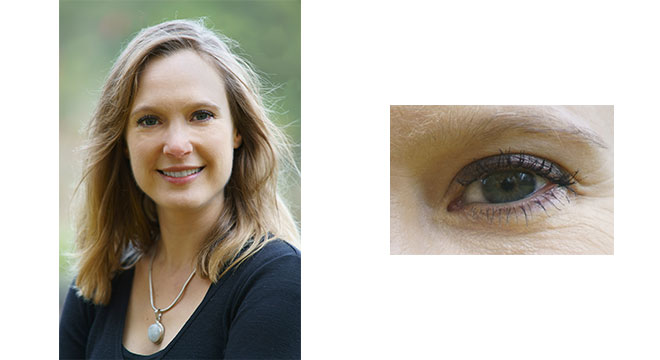
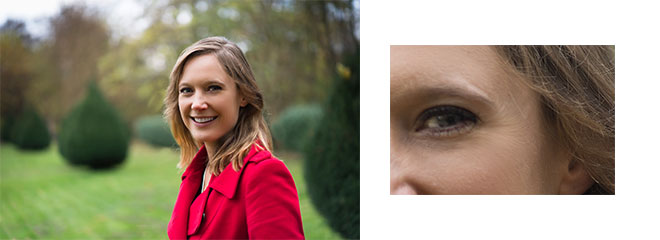
Face Detection technology has been around for years, and it is a great help when shooting images of a single person or of groups. However, for dedicated headshots and elaborate portraits, precise focus on the eyes is required, even more so when you want to create a special three-dimensional look using a large aperture. For this purpose, Sony has introduced the [Eye AF] function.
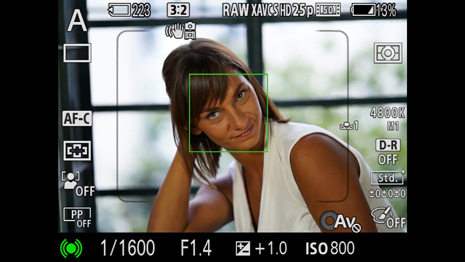

The traditional method of focusing in such a case would be to use spot AF with the focus locked on the eyes, then recompose, and finally take the picture. However, this is less practical, as it requires recomposing every time the subject moves. Furthermore, when using a very large aperture lens, such as an 85mm F1.4 or a 135mm F1.8, the depth of field is extremely shallow and some focus-shift can be caused by recomposing with the focus locked.
When using [Eye AF], the camera automatically focuses on the eye, as long as it is covered by one of the AF sensors of the camera. You do not need to use cumbersome focus lock operations or recompose anymore!
Using Eye AF in Continuous AF mode (ILCE-7RM2 only)
The [Eye AF] function on the ILCE-7RM2 is not limited to AF-S (Single-shot AF) mode anymore. It is available when using AF-C (Continuous AF) mode as well. This allows you to have the camera focus on the eye even if the subject is in motion during shutter release or during continuous shooting. When pressing the custom button assigned to [Eye AF] in AF-C mode, the eye will be tracked if it is moving around in the frame or if you change the composition. It would be extremely difficult, if not impossible, to perform this operation manually using traditional shooting techniques.
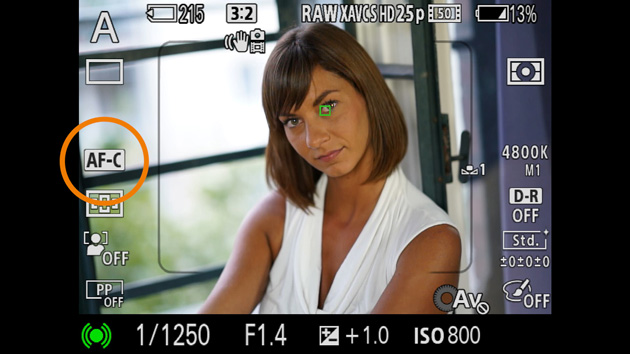

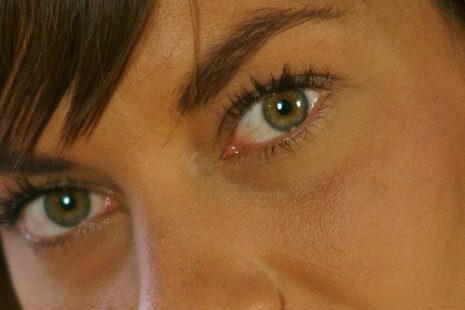
Focus Area for Eye AF
When using [Eye AF], focusing on the eye takes priority over the focus area settings. This means that you can use the focus area selection of choice, and still the focus can be set on the eye by quickly pressing the single button to which the [Eye AF] function is assigned. You do not need to change the focus area settings.
Generally, the camera will focus on the eye that is closer to the camera, and you will always see one single green square on the eye to indicate the [Eye AF] working.
Using Face Detection and Eye AF
You can use the [Eye AF] function without Face Detection enabled. However, it makes sense to have Face Detection enabled when shooting with the [Eye AF] function.
The reason for this is that once the camera has detected a face using Face Detection, it will also adjust the exposure and white balance for optimized skin exposure and color rendition. This is a great help in avoiding overexposure of the skin tones when using a flash, for example. When using [Eye AF] without Face Detection enabled, the camera will not automatically adjust exposure and white balance for this purpose.


When Face Detection is enabled, the small green indicator for the [Eye AF] will disappear shortly after it is lit, and the green face detection frame will appear on the detected face.
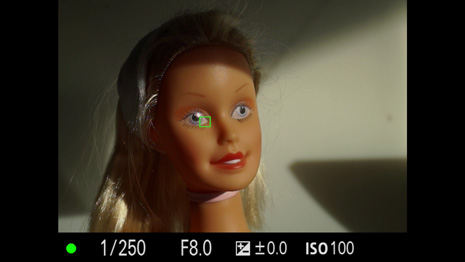

If the camera cannot detect the eyes for some reason, Face Detection will be activated instead, even if the function is currently deactivated.
Tutorial Video
Separating autofocus from the shutter button
When the [AF w/ shutter] is set to [Off], you can assign the focusing function and the shutter release function to different buttons. For example, you can assign the [AF-On] function to the center button and the [Eye AF] function to the AF/MF button.
In this case, if [Focus Area] is set to [Center], for example, pressing the center button will focus on the center of the screen, while pressing the AF/MF button will focus on the eye immediately in portrait shooting.
Minimum distance
If the eyes are not detected by the [Eye AF] function in a close-up shot, a face has to be detected first.
To detect a face, the whole face has to be on the screen. If large parts of the face are outside of the screen, the face may not be detected. So, for close-up shots of the eyes, please use [Flexible Spot] and move the autofocus area to the position of the eye.

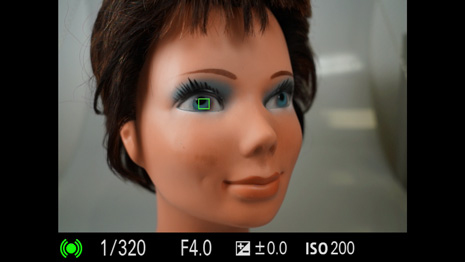
If a face is a size that can be detected by the camera, [Eye AF] works.
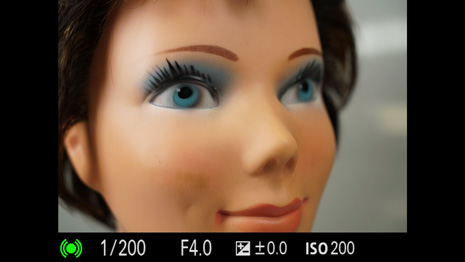
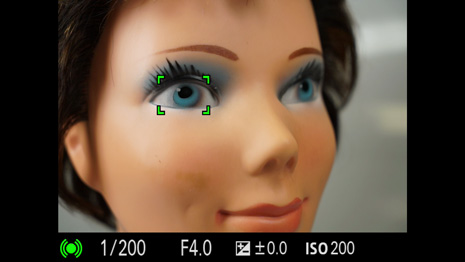
When the distance to the subject is too short for a face to be detected, [Eye AF] will not work. Use [Flexible Spot] instead.
Direct Manual Focus
When the camera is not able to use [Eye AF], for example when the distance to the face is too short or the head is turned in profile, you can use the Direct Manual Focus (DMF) function to fine-tune the focus in order to ensure the most accurate focus.
Set [Focus Mode] to [DMF]. Once you rotate the focus ring on the lens, [MF Assist] (Focus Magnifier) is engaged and shows the enlarged view on the monitor or the viewfinder to make it very easy to adjust the focus.
When using [DMF], be sure to enable the [MF Assist] function using the Custom Settings in the MENU.

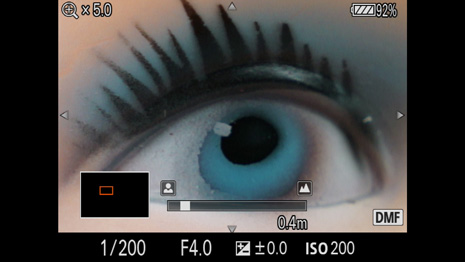
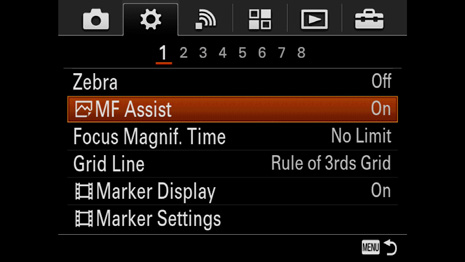
Restrictions
- [Eye AF] may not function in the following situations:
- When the camera cannot detect a person's face
- When the person is wearing sunglasses
- When front hair covers the person's eyes
- In low light or backlight conditions
- When the eyes of the person are closed
- When the person is in the shade
- When the person is out of focus
- When the person is moving too much
- If the person is moving too much, the detection frame may not display correctly over their eyes.
- [Eye AF] may not work when an A-mount lens is attached using the Mount Adaptor.